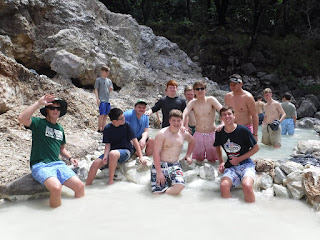Day 7: Science and a Cooking Class - Eliot Seifrit
What a view!
Eliot making the beans.
Nice tortilla Cole.
Great Celebration
Today was our seventh day in Costa Rica and one of our last
days on Pablo’s chocolate farm. Also, today
was one of our last days to finish up our projects. Picking a question to do our research on was
very difficult, but my group, the 3 A.M BEANS,
finally decided on doing research on escovopsis growth in different aged
atta ant colonies. The first day of our research we went into the woods to
collect one fungus garden from three different ages of atta colony, young,
medium, and mature. Collecting the
fungus garden was quite difficult, first you must find a tunnel in the colony
that leads to the garden, then you must deal with the soldier ants while trying
to extract the fungus garden. First, we went
the farthest into the woods to get the medium ages colony. It didn’t take long to find the fungus garden
but when we tried to take it out there were soldier ants everywhere, these ants
can pierce through your skin and they will usually draw blood. While we had someone trying to get the garden
out, the rest of my group would flick soldier ants off their legs. Once you get the ant off your leg or pant, if
the soldier ants get a good grip, their head will stay locked on. Dr. Pinto told us that you can use that
feature as makeshift stitching to close an open wound or sow clothing back
together. On our way back to the lab we
found the mature colony, this one took us a while to find a fungus garden. One of the biggest colonies we found was a
few days ago and Dr. Pinto told us that the colony was about five years old and
there were around 900 fungus gardens.
When we opened the mature colony there were hundreds of soldier ants
piling out and we had to work very hard to keep them off whoever was digging. Also, on the way back we found the small
colony, this colony had only one fungus garden and took all about two minutes
to dig out. My entire group forgot water,
which resulted in Heath getting dehydrated and us having to carry him back to
the lab. Once we got back to the lab, we
took tiny samples of the fungus garden from the bottom and placed them in four petri
dishes per fungus garden. The petri dishes
have a slimy substance that is a combination of potato, dextrose (sugar), and
agar (nutrients). We checked the escovopsis
after 24 hours, 48 hours, and 53 hours.
After 24 hours we saw almost no growth in any of the three colonies. We made the mistake of not letting the containers
open for a while so they can get oxygen.
The next day in the morning the entire medium colony that we collected appeared
to be dead. But, after a half an hour of
the ants being exposed to oxygen, they were all back up like nothing had happened. After all our science today we took a tractor
up the street to a kitchen where we did a cooking class where we made rice,
tortillas, and chicken wings. It was good. That was awesome.

Groups preparing for their experiments.

Digging up the ant colonies to grow escovopsis.






Excellent post! Who doesn’t love science and cooking?!
ReplyDelete